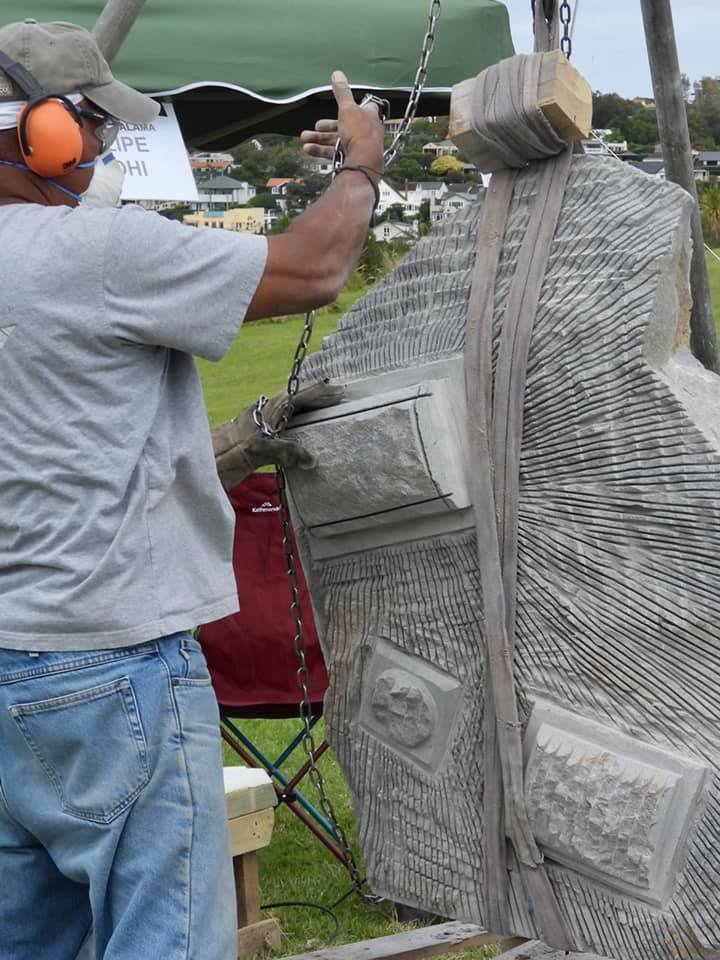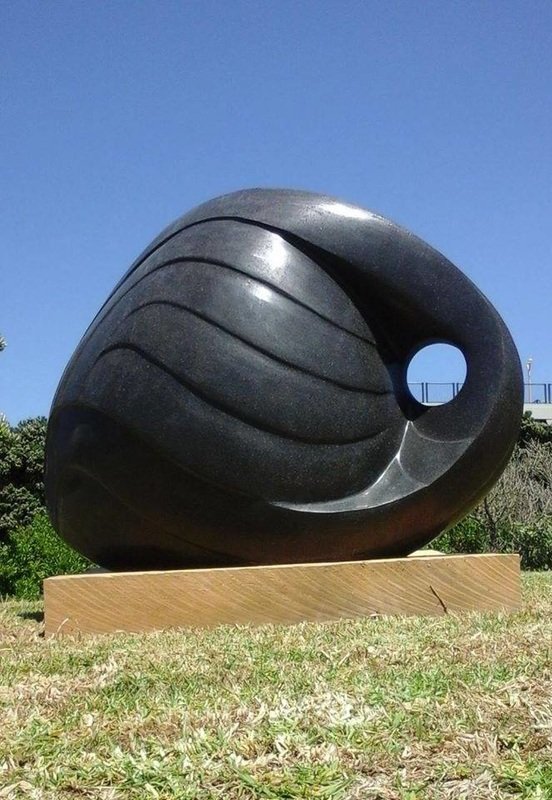We visit the Raumati Toi Sculpture Symposium
In an outdoor area buzzing with activity, the Raumati Toi Sculpture Symposium is an incredible opportunity to view artworks by twenty sculptors working within Aotearoa.
Spanning artists who practice across wood, hard and soft stone, metal, and paint, the Symposium offers the unique chance to engage with each sculptor whilst they are working and see artworks at different stages of the creation process. Visitors who are sensitive to noise or dust might want to bring a mask or earplugs to have on hand, as the live-action making means multiple pieces of equipment are often in use!
Raumati Toi was brought together by Lawrence Makoare (Ngāti Whātua Orākei), a sculptor working mainly in wood and Oamaru stone. As well as being an incredible place to meet established artists, the event is also a learning opportunity for ten rangatahi who are being guided through the process of how to sculpt an Oamaru sculpture of their own design. Makoare writes, “I enjoy working with likeminded people that spur me on to create more traditional and contemporary pieces made with blood, sweat and a whole lot of aroha; and to share my knowledge with youth that are willing to learn and be creative.”
All pieces made during the two-week event will be auctioned on the closing day at 4 pm, Sunday 28 March.
We highlight seven artists from the event below.
Logan Okiwi Shipgood is a sculptor, art director and set designer. In 2015 he opened Penny Haka gallery in Rotorua.
“The physical is one of the planes that we are living in at the moment. In Māori mythology, when Māui climbed up through the twelve heavens, in search of the three baskets of knowledge, this plane was just one of them.”
—Logan Okiwi Shipgood
Logan Okiwi Shipgood at the Raumati Sculpture Symposium, March 2021. Kytaja Photography by Tania Brown
Logan Okiwi Shipgood at the Raumati Sculpture Symposium, March 2021. Kytaja Photography Tania Brown
Sopolemalama Filipe Tohi is one of Aotearoa's foremost sculptors. Many of his artworks are based upon the ancient Pasifika art of lavala (lashing), a binding technique that evokes physical and metaphorical ties to cultural knowledge.
Sopolemalama Filipe Tohi, Haukulasi, 2017, acrylic yarn and cardboard tubes, overall 183 (h) x 272 (w) x 84 (d) cm. Courtesy of Te Papa Tongarewa
Sopolemalama Filipe Tohi writes of his Ta Maka (stone carvings): “The most common patterns...are based upon geometric forms, often a combination of squares, triangles, and lines. Often these patterns are inspired by Tongan kupesi (Tapa cloth pattern boards) as well as the Langi tombs of Tongatapu.”
Sopolemalama Filipe Tohi at the Raumati Sculpture Symposium, March 2021. Kytaja Photography by Tania Brown
Uenuku Hawira has been sculpting for over 12 years. He creates taonga from natural materials such as wood and stone, and is also an expert in Tā Moko.
“[I aim] to be able to connect Joe Bloggs down the road with indigenous sculpture, and empower him with it. I’m hoping that my works become foundation stones for korero to come, bringing our traditions into the future. I would like to see people unified on a real whanau level, and get back to their roots.”
—Uenuku Hawira
Artwork ready for staining, February 2021. Image courtesy of the artist
Uenuku Hawira at the Raumati Sculpture Symposium, March 2021. Kytaja Photography by Tania Brown
Kendra Hanley describes her sculptures as “organic shapes with soothing curves and tranquil lines.” After finding a curiosity and affinity with Oamaru stone whilst travelling the South Island in 2005, she became “hooked” on the medium and has been sculpting almost full-time since.
Kendra Hanley at the Raumati Sculpture Symposium, March 2021. Kytaja. Photography by Tania Brown
“I [sculpt] using a slow pace and steady method, with just a hammer and chisel. It feels familiar and more intimate. I enjoy the challenges and surprises along the sculpting journey as the hidden forms start to emerge from the stone, and the light and shadows begin to play.
My art is mainly inspired by patterns found in nature, and also the interactions and feelings that are exposed within human relationships.”
—Kendra Hanley
Steve Molloy's sculptural forms are often meticulously finished and highly polished. He plays with space and illusion to highlight geometry and wonder within the natural world.
“My work is inspired by repetitive geometry and the golden ratio [found] in nature. I use various mediums to represent this, [including] sculpture, painting and photography.”
—Steve Molloy
Steve Molloy at the Raumati Sculpture Symposium, March 2021. Kytaja Photography by Tania Brown
Steve Molloy at the Raumati Sculpture Symposium, March 2021. Kytaja Photography by Tania Brown
Jocelyn Pratt sculpts modernist forms that evoke the natural world. She brings her artworks to life through utilising local resources and has developed unique polishing and texture techniques that enhance the qualities of the stone.
“The work I am doing for the Raumati Toi Sculpture Symposium is based on a Pacific double-sail, referencing journeys not only on the sea but also in life. When working with new stone I first remove the surface to check how the stone works — how hard it is, if it has high silica content, feldspars, etc. This helps determine the blades I use, and also enables me to see if there are any fractures in the stone. In this work, I have removed 90% of the stone, which is not unusual for me. Throughout the process I am constantly refining the piece until it is finished.”
—Jocelyn Pratt
Jocelyn Pratt, Aqua Anchor. Courtesy of the artist
Jocelyn at the Raumati Sculpture Symposium, March 2021. Kytaja Photography by Tania Brown
Having worked as a sculptor since the early 2000s, Paul Brunton utilises ecologically sourced native hardwoods to create artworks with a sense of dynamism and fluidity.
“My works are influenced particularly by our New Zealand way of life and environment along with exposure to many different cultures through my travels. Throughout my life I have felt a strong connection to the outdoors, starting as a boy scout and developing as a keen yachtsman, surfer, tramper and kite surfer. I hope that my works convey the beauty and fragility of our world and its creatures that we as humans have the greatest power to nurture and protect. When I am in ‘flow’, I feel that the resulting works encapsulate this spirit, the euphoria and fluidity that is intrinsic to nature.”
—Paul Brunton
Paul Brunton at the Raumati Sculpture Symposium, March 2021. Kytaja Photography by Tania Brown
Paul Brunton at the Raumati Sculpture Symposium, March 2021. Kytaja Photography by Tania Brown













